Difficult terrain and intense weather conditions hampered rescue efforts yesterday as ground forces and helicopters worked to rescue about 400 travelers trapped on the coastal Suhua Highway on Thursday by massive rockslides unleashed by the torrential rains of Typhoon Megi.
32 vehicles carrying 400 people were stranded between the 113km and 115km markers on the section of Suhua Highway between Yilan County’s Suao (蘇澳) and Dongao (東澳) townships following the landslides, said Minister of the Interior Jiang Yi-huah (江宜樺), who doubles as commander of the Central Emergency Operation Center (CEOC).
Twelve of the stranded vehicles were tour buses carrying 274 Chinese tourists, he said.
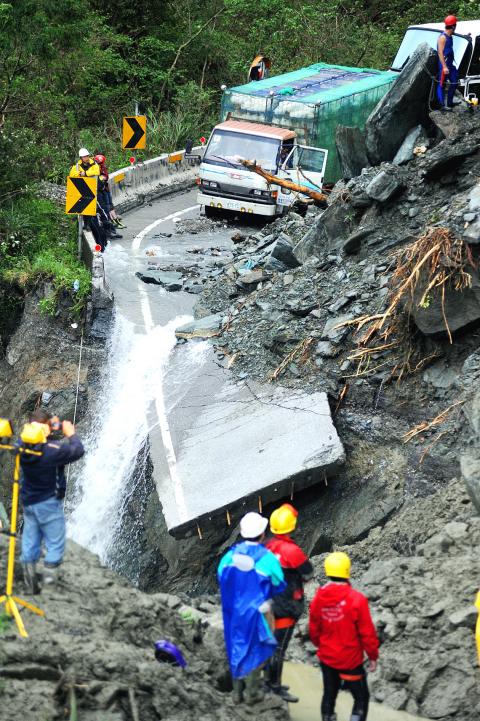
PHOTO: CHANG CHIA-MING, TAIPEI TIMES
One of the vehicles was hit by a huge rock, local TV stations reported, but the 16 Chinese tourists inside escaped with no major injuries.
Authorities, however, confirmed that one tour bus carrying Chinese tourists was found after having tumbled 100m down a ravine at the 112.8km mark of the highway after being hit by a rockfall. The 19 Chinese nationals, a Taiwanese tour guide and a bus driver from Harula Tour Agency (創意旅行社) who were on the bus remained unaccounted for at press time.
Jiang also confirmed that another bus belonging to a different travel agency had fallen off the cliff into the sea.
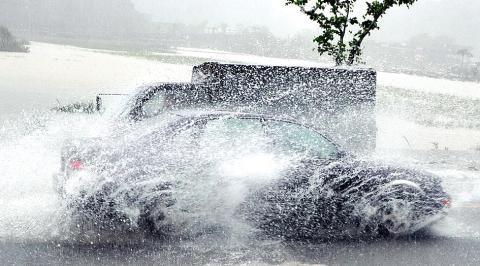
PHOTO: CNA
“Vessels patrolling the Pacific coast found a bus washed down into the sea by a mudslide at the 134km location [of the Suhua Highway],” Jiang said. “Rescuers have confirmed that the tour bus belongs to Hong Tai Tour Agency (弘泰旅行社).”
Although all 19 passengers on board the bus made it out just in time, they told reporters that the Taiwanese bus driver and the Chinese tour guide did not make it out before the bus fell.
The National Airbone Service Corps yesterday morning attempted to launch several airlift missions from Hualien to try to deliver food and water to those who were stranded in their vehicles on the Suhua Highway, but all the missions had to be aborted because of poor visibility over Hualien.
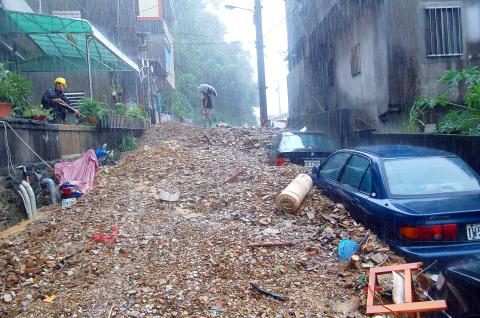
PHOTO: CHIANG CHI-HSIUNG, TAIPEI TIMES
Two S70 helicopters dispatched by the military from Taipei, carrying dried food and mineral water, managed to reach the 114km mark of the highway at around noon. A CH47 helicopter with a larger load capacity also made a flight yesterday afternoon to help evacuate those stranded, the Ministry of National Defense said.
Meanwhile, ground forces were sent to the 112km, 114km and 116km markers of the highway to deliver bread and dry food to the victims via line throwers. Insulin was also sent to two diabetics among the stranded people, the ministry said.
As of press time, 347 people had been airlifted to three hospitals in Yilan and Hualien counties.
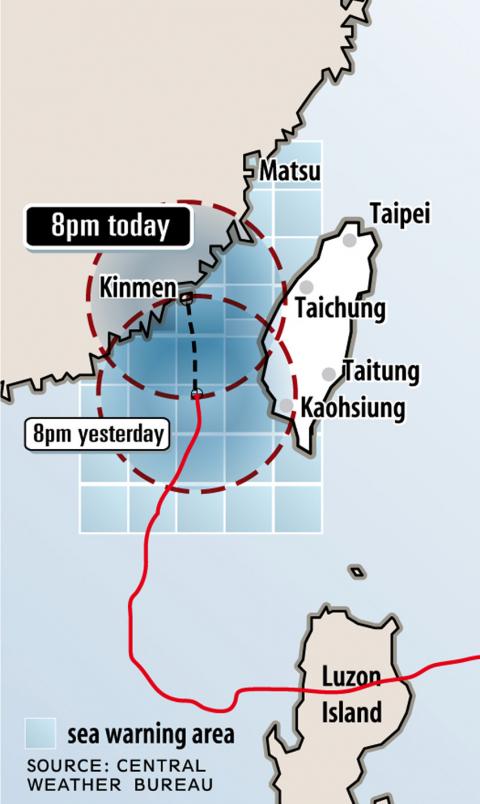
Because of difficult terrain and harsh weather, many of the rescue team members were forced to enter the disaster zone on foot.
It was the worst damage ever sustained on the winding scenic route connecting Yilan and Hualien, the National Freeway Bureau said. Most of the rockslides occurred between the 112km and the 116km markers.
Jiang said the landslides also caused a 500m long section of the roadbed between the highway’s 115km and 116km markers to sink about 20m.
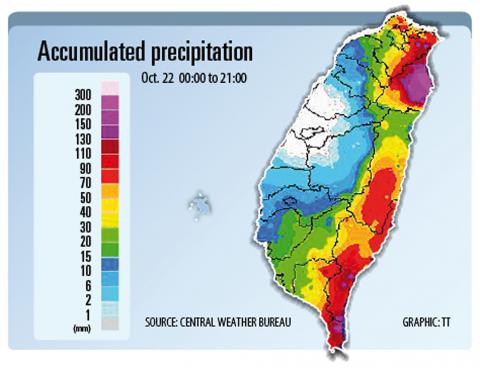
The Beijing-based Association for Relations Across the Taiwan Strait yesterday morning sent a letter to its Taiwanese counterpart, the Straits Exchange Foundation, to express concern for the Chinese nationals affected by the landslides on the highway.
Premier Wu Den-yih (吳敦義) told reporters yesterday that the government was exerting all efforts to ensure that those stranded remained safe.
Meanwhile, seven people were found dead in a temple engulfed by mudslides set off by the typhoon, an official said yesterday, warning that others might be buried under the debris.
Rescuers dug up seven bodies, including two nuns, buried under the debris of Bai Yun Temple (白雲寺) in Suao an official at the local fire department said.
Yilan County Commissioner Lin Tsung-hsien (林聰賢) said rescuers were using bulldozers to try to dig out two other people.
Although the rain was continuing in the northeast yesterday, it was beginning to abate, while rain and wind was increasing in the south with the approach of Megi.
Residents in parts of Yilan, Taipei and Hualien counties, however, were warned to remain alert to the dangers of torrential rain or extremely torrential rain, defined as 24-hour rainfall exceeding 200mm and 350mm respectively, because of the combined effects of Megi’s outer rim and seasonal winds, the Central Weather Bureau (CWB) said.
The CWB reported that as of 9:15pm, Megi was centered 180km south-southwest of Penghu, moving north at 10kph toward China.
The storm, packing maximum sustained winds of 137kph and gusts of 173kph, was affecting the southwestern coast and was posing a direct threat to that area and to the outlying islands of Penghu and Kinmen, the CWB said.
In Kaohsiung yesterday afternoon, the city government announced that classes and public services were suspended for the rest of the day. It also ordered all city fire fighters, police and rescue personnel to remain on standby for any possible contingencies.
In addition to Kaohsiung City, Kaohsiung County, Tainan City and Pingtung County announced class and office closures for the remainder of the day.
The central government also updated its red-coded landslide warning earlier in the day, reporting that the number of rivers in danger of bursting their banks and causing landslides downstream had been reduced from 96 to 43, all in Yilan County.
The report also said the number of yellow-coded rivers had been increased from 142 to 195, all of which were in either Taipei City, or in Yilan and Taipei counties.
CWB statistics showed that from Thursday midnight to 11am yesterday, precipitation had reached 685mm in Qingtiangang (擎天崗) in Taipei’s Shilin District (士林), 568mm in Taiping (泰平), Taipei County, 406mm in Chishan (池山), Pingtung County, and 294mm in Wudu (五堵), Keelung.
Accumulated precipitation in Yilan County’s Suao Township had reached 1,064mm as of 9am, breaking the previous record of 808.5mm recorded in Pingtung County’s Dawu Township (大武) during Typhoon Morakot in August last year.
Because of the heavy rain, 50 houses in Suao were destroyed by landslides, with broad swaths of farmland in Yilan County under several meters of water, the CEOC said. No casualties were reported in those landslides as more than 2,500 residents had been evacuated, it said.
Meanwhile, Taipei City Government apologized for advising about the closing of the floodgates along the Keelung River (基隆河) too late and promised to give a NT$20,000 compensation to owners of waterlogged cars.
Those whose scooters were submerged in the flood would receive compensation of NT$2,000, the city government said.
Taipei Mayor Hau Lung-bin (郝龍斌) said the city’s Water Resources Office notified the media at about 5pm on Thursday that it would start closing the floodgates at 7pm and that it had completed the measures by 9pm.
He said the office did not give owners enough time to pick up their vehicles before the floodgates were closed because of the quickly rising water level of Keelung River.
The office said about 40 to 50 cars and scooters were submerged. Compensation would be paid as soon as possible, it said.
ADDITIONAL REPORTING BY LOA IOK-SIN AND MO YAN-CHIH

AIR SUPPORT: The Ministry of National Defense thanked the US for the delivery, adding that it was an indicator of the White House’s commitment to the Taiwan Relations Act Deputy Minister of National Defense Po Horng-huei (柏鴻輝) and Representative to the US Alexander Yui on Friday attended a delivery ceremony for the first of Taiwan’s long-awaited 66 F-16C/D Block 70 jets at a Lockheed Martin Corp factory in Greenville, South Carolina. “We are so proud to be the global home of the F-16 and to support Taiwan’s air defense capabilities,” US Representative William Timmons wrote on X, alongside a photograph of Taiwanese and US officials at the event. The F-16C/D Block 70 jets Taiwan ordered have the same capabilities as aircraft that had been upgraded to F-16Vs. The batch of Lockheed Martin

GRIDLOCK: The National Fire Agency’s Special Search and Rescue team is on standby to travel to the countries to help out with the rescue effort A powerful earthquake rocked Myanmar and neighboring Thailand yesterday, killing at least three people in Bangkok and burying dozens when a high-rise building under construction collapsed. Footage shared on social media from Myanmar’s second-largest city showed widespread destruction, raising fears that many were trapped under the rubble or killed. The magnitude 7.7 earthquake, with an epicenter near Mandalay in Myanmar, struck at midday and was followed by a strong magnitude 6.4 aftershock. The extent of death, injury and destruction — especially in Myanmar, which is embroiled in a civil war and where information is tightly controlled at the best of times —

China's military today said it began joint army, navy and rocket force exercises around Taiwan to "serve as a stern warning and powerful deterrent against Taiwanese independence," calling President William Lai (賴清德) a "parasite." The exercises come after Lai called Beijing a "foreign hostile force" last month. More than 10 Chinese military ships approached close to Taiwan's 24 nautical mile (44.4km) contiguous zone this morning and Taiwan sent its own warships to respond, two senior Taiwanese officials said. Taiwan has not yet detected any live fire by the Chinese military so far, one of the officials said. The drills took place after US Secretary

THUGGISH BEHAVIOR: Encouraging people to report independence supporters is another intimidation tactic that threatens cross-strait peace, the state department said China setting up an online system for reporting “Taiwanese independence” advocates is an “irresponsible and reprehensible” act, a US government spokesperson said on Friday. “China’s call for private individuals to report on alleged ‘persecution or suppression’ by supposed ‘Taiwan independence henchmen and accomplices’ is irresponsible and reprehensible,” an unnamed US Department of State spokesperson told the Central News Agency in an e-mail. The move is part of Beijing’s “intimidation campaign” against Taiwan and its supporters, and is “threatening free speech around the world, destabilizing the Indo-Pacific region, and deliberately eroding the cross-strait status quo,” the spokesperson said. The Chinese Communist Party’s “threats